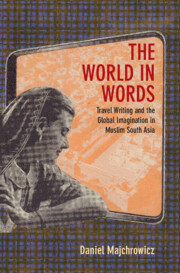Introduction
Published online by Cambridge University Press: 28 February 2023
Summary
It was in Rampur, a small town a few hours northeast of Delhi, that I first heard tell of a local library with thousands of books, but only three walls. Of course, I went to investigate immediately. I introduced myself to the head librarian of this curious institution and explained that I was writing a book on nineteenth- and twentieth-century Urdu travelogues, or safarnamas, and their place in South Asian social and literary history. Could I review the library’s collections? I asked gingerly. The librarian quickly assured me that I was free to use whatever material I wanted, but only so long as I managed to find anything usable. “The library’s still functioning,” he said, “but the back wall came down in a rainstorm. A lot of books were destroyed.” The travelogue section had been one of the storm’s casualties.
Stepping into the main reception area of the Saulat Public Library, I saw a few men seated at tables, sipping tea and reading the newspaper. Behind them, sunlight streamed in from a cavernous opening at the far side of the room. It was true. The wall really had collapsed. All of the books that had been damaged by the cave-in—including most of the library’s travelogues—had been piled together in an adjoining room that lacked both ventilation and electricity. The shelves were in fantastic disarray, with hundreds of books piled about at random. Some were waterlogged, while others were brittle and ravaged by termites. A good number, though, were still intact. For a week, we picked our way through the heaps, ultimately retrieving dozens of colonial-era travelogues in Urdu and Persian. I made digital copies of them all and returned home to New Delhi to inspect our findings.
Flipping through the files, the first thing to strike me about the travelogues in Saulat’s collection was how many of them were local productions. Though their subject matter spanned the globe, the books themselves came from authors or presses located in or near Rampur. Their cover pages trumpeted their author’s destinations (“Mujtaba Khan’s voyage … to Egypt, Jerusalem, and the Levant…”), with the place of publication (“Printed in Rampur”) in a smaller font below (Figure 1.1).
- Type
- Chapter
- Information
- The World in WordsTravel Writing and the Global Imagination in Muslim South Asia, pp. 1 - 34Publisher: Cambridge University PressPrint publication year: 2023

